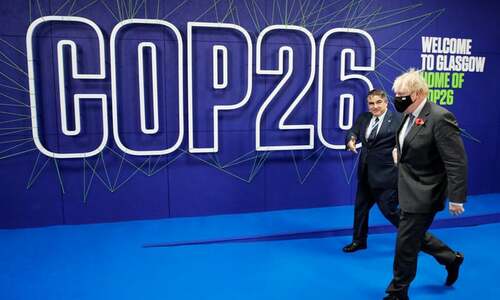GLASGOW: COP26’s first week saw keynote pledges to end deforestation, phase out coal, and mobilise trillions for green investment.
But observers say there is a gulf between host Britain’s proclamations and the emissions cuts that must be achieved.
Mohamed Adow, director of the Nairobi-based climate think tank Power Shift Africa, said that there had been “two realities” at the global climate conference in Glasgow.
“One is the world of press releases by the UK Government announcing a host of initiatives such as ‘an end to coal’, which suggest all is well and we’ve as good as cracked the climate crisis,” he said.
“The other reality is outside this PR bubble. The climate deals in cold hard facts.” The conference aims to implement the Paris Agreement — including the goal of limiting temperature rises to between 1.5 and 2 degrees Celsius above pre-industrial levels.
British organisers are pushing to solidify 1.5C as the summit’s unequivocal temperature target.
They have also pushed for their much-repeated priorities — “coal, cars, cash and trees” — shorthand for actions to phase out polluting fuels and internal combustion vehicles, provide money to help the world decarbonise, and protect forests.
There was movement towards that end at COP26 this week.
A COP26 spokesman said there had been “real momentum for climate action” including “commitments on ending our reliance on coal, increasing climate finance, tackling deforestation and plans to cut emissions.” But experts say there is actually a glaring disconnect between what some called “inflated, rehashed pledges” and genuine progress on reducing fossil fuel emissions.
On Wednesday, for instance, COP26 president Alok Sharma announced: “A 190-strong coalition has today agreed to phase out coal power”.
Business Secretary Kwasi Kwarteng tweeted: “The end of coal is in sight.” The 190 figure was given to the media under embargo on Tuesday night, but a list of signatories was not released until the following day.
It contained only 77 new signatories, including 46 countries, on top of others that had already signed on to a previous alliance to end coal.
Out of these, COP26 organisers said 23 countries had issued new pledges to phase out coal during the summit, including major users South Korea and Vietnam.
But in the list of countries with new commitments, 10 nations use no coal at all in their energy mix, according to data from the Ember climate think tank.
All told, national signatories to the COP26 coal pledge account for around 13 percent of global output.
On Monday, Downing Street said that countries representing 85 percent of global rainforests had signed an “unprecedented” pledge to end deforestation by 2030.
But it was similar to the 2014 New York Declaration on Forests, signed by 40 countries and more than 150 organisations and indigenous groups, to strive to end deforestation, also by 2030.
An assessment this year on the declaration’s progress found that out of the 32 biggest forest nations, only India had translated the pledge into concrete action.
Damian Fleming, deputy lead at WWF’s Global Forest Practice, said the COP26 deforestation pledge was “unprecedented in scale... but not in ambition.” “We have been here before. Yet since (the New York declaration) a forested area greater than the size of France has been deforested,” he said.
“The pledges are coming fast and furious. But they all seem to be just business-as-usual wearing a green cloak of trees,” Doreen Stabinsky, Professor of Global Environmental Politics at the College of the Atlantic, said.
“There aren’t enough trees on the planet to just keep blindly carrying on emitting.”
Finance is a crunch issue at COP26, with developing nations demanding rich emitters make good on decade-old promises to provide $100 billion a year to help them cope.
That figure is a drop in the ocean compared to the estimated $4 trillion needed annually to decarbonise the economy by 2050.
Published in Dawn, November 8th, 2021

















































